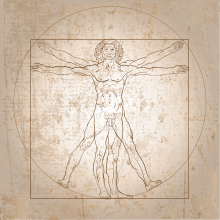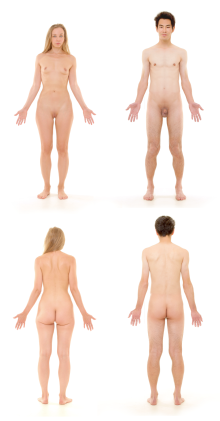Human body
The human body is the material part of the human being .
When talking about the human body, i. d. Usually the body in the biological sense or the body as an organism is meant, but the human body can also be understood as a body in the geometric or physical sense , i.e. H. as a body with limited dimensions, which is bounded by a complex envelope surface and has a mass.
The human body is characterized by some peculiarities. Compared to most other mammals , it has little body hair , a brain that is extremely large compared to its size and an upright gait . As a result, the front legs (front extremities) become arms (upper extremities), which are no longer used directly for locomotion, but for gripping and thus the improved ability to transport objects and use tools , which in turn enables manual activity.
The human body from different professional perspectives
Natural sciences
From a scientific point of view, the human body is an organic whole made up of cells and has a genetically defined shape. Without the metabolic processes serving to sustain it, it decays. The inanimate human body is called a corpse and decays. Artificial preservation as an anatomical preparation or as a mummy is excluded from this . The Anatomy deals with the structure of the body. In anatomy, the human body is divided into a trunk (with a head , neck and trunk ) and the upper and lower extremities . The physiology and biochemistry deal with the controls and the metabolic processes of the body apart, the genetics deals with the information processes. Diseases, functional disorders and possible healing of the body form the subject of medicine . The human body is made up of ten to 100 billion cells . Previous scientific evidence has shown that the organic and inorganic matter of the human body (essential) of the 26 essential and non-essential eleven (non-essential) elements is composed.
| Surname | symbol | Dimensions | Surname | symbol | Dimensions |
|---|---|---|---|---|---|
| oxygen | O | 45.8 kg | Rubidium | Rb | 1.4 g |
| carbon | C. | 17.7 kg | strontium | Sr | 0.3 g |
| hydrogen | H | 7.05 kg | Zirconium | Zr | 0.3 g |
| nitrogen | N | 2.10 kg | bromine | Br | 140 mg |
| Calcium | Approx | 1.05 kg | niobium | Nb | 100 mg |
| phosphorus | P | 0.70 kg | aluminum | Al | 35 mg |
| sulfur | S. | 175.0 g | cadmium | CD | 30 mg |
These elements are called bio- elements . Essential bio-elements have certain (partly unknown) biological functions, so that the deficiency or excess of such elements can lead to diseases . The table shows the most common elements in the human body (adult, 75 kg person). Essentially, other organisms are made up of the same elements, although the proportions of the abundance differ. The division of the elements into essential and non-essential can also differ in other organisms. Most elements belong to the first, second or fourth period of the periodic table . The table also shows that the elements carbon , oxygen and hydrogen make up by far the largest proportion of the weight: 94.07% of the human body is made up of three elements mentioned. The elements are made up of different compounds , the following being the most common: water (which is needed as a reaction medium and solvent ), calcium carbonate and phosphate (which form the structural substance in bones ), sodium chloride (functions as an electrolyte ) and, above all, proteins , Sugar and fats . The basic structure of the latter is formed by hydrocarbon compounds and makes up the essential, organic part of the human body. Other trace elements often act as active centers in enzymes , e.g. B. Iron in hemoglobin . The distribution of the abundance of the elements can be traced back to the earth's shell : during the development of the biological species, they made use of particularly frequent and easily accessible elements. With regard to the formation of the universe, the thesis is often formulated that many of the elements present in humans represent parts of former stars, i.e. humans consist of stardust .
Law
Among the human rights include the right to physical integrity . Unauthorized interference with physical integrity constitutes physical harm .
Philosophy and theology
Thinking in the dualism of soul and body, sometimes also soul, spirit and body, is characteristic of the European tradition of thought . There are, however, other positions in the history of European philosophy . The preoccupation with the relationship between soul and body (often referred to as body ) or between body and spirit occupies a large space in the history of European philosophy; this problem is known as the body-soul problem .
In Gnosis and Hellenistic Christianity , the body was understood as the “dungeon of the soul” or the “grave of the soul”.
Julien Offray de La Mettrie described the human body as a machine ( l'homme machine ).
Maurice Merleau-Ponty emphasizes the connection between the self, the body and the other: the human body mediates between the transcendental self and the experience of the outside world.
Michel Foucault took a critical look at social techniques for disciplining the body.
Physicality and attitudes towards the body
Based on different ideological attitudes, the physical side of human existence takes on a very different role in the life of individual people. This is also heavily dependent on the value system of the social environment. The spectrum ranges from hostility towards the body to the cult of the body (e.g. in the bodybuilding scene ). While many facets of corporeality, especially in Europe and the western world, have long been suppressed (especially sexuality), since the 19th century gradually a discovery and more positive assessment of aspects of corporeality began. Steps in this direction were the establishment of gymnastics and sport in the 19th century, as well as the physical culture movement close to the life reform movement, the so-called sexual revolution in the 1960s ( 68 movement ) and the changes in clothing fashion . Through the detailed exploration of the human body in motion as part of exercise science , the modern understanding of the human body has learned a great deal from exercise and exercise science .
Both tendencies of hostility towards the body and the increased cult of the body are discussed in society and often criticized.
The body as an external appearance of the human being
The outer appearance of a person consists largely of the shape and surface texture of his body. The external appearance is usually supplemented by objects that the person wears on the body, in particular jewelry and clothing.
Depending on the cultural context, there are very different ideas about the extent and to what extent the naked body or parts of it (especially in public ) may or should be made visible.
Clothing is an important part of this. Clothing can serve the purpose of covering the body as well as of emphasizing or showing off the body or certain body parts.
In many cultures, great attention is paid to maintaining, modifying and / or increasing the attractiveness of the human external appearance. In addition to personal hygiene , clothing and jewelry often play a major role, as do other body design measures that either relate to changing the figure (losing weight, bodybuilding, etc.) or changing the surface (skin / nails / hair).
Clothing can significantly change the appearance of the body, for example by influencing the proportions and the perceptible size. The wider, more rigid and more veiled the clothing, the more a person's external perception is determined not by his body, but by his clothing.
The human body in the fine arts
The human body is also a recurring theme in the fine arts. On the one hand as an object of painting, photography and film, of sculpture and plastic, etc. The z. B. in portrait and nude painting , as well as in nude and portrait photography in appearance. On the other hand, in contemporary art, the body can also become an art medium (e.g. in performance , happening ) or a painting surface. This tendency and the preoccupation with the body is particularly pronounced in Body-Art.
See also
literature
- Jacques Le Goff , Nicolas Truong: The History of the Body in the Middle Ages. Klett-Cotta, Stuttgart 2007, ISBN 978-3-608-94080-0 .
- Teresa Platz: Anthropology of the body: From the body as an object to the body as a subject of culture. Berlin 2006.
- Philipp Sarasin : Irritable machines. A history of the body, 1765-1914. Frankfurt am Main 2001.
- Schaal, S. et al. (2016): The human being in numbers: A data collection in tables with over 20,000 individual values . 4th edition. Berlin: Springer. P. 268ff. ISBN 978-3-642-55399-8 , doi: 10.1007 / 978-3-642-55399-8
- Antje Stache: The body as the center: To dynamize the concept of the body with practical demands. Berlin 2008 (diss.)
Web links
Individual evidence
- ↑ Michael Schünke: Functional Anatomy - Topography and Function of the Movement System. Georg Thieme Verlag, 2000, ISBN 978-3-131-18571-6 , p. 103.
- ↑ Holleman, A. & Wiberg, N. (2017): Inorganic Chemistry , Volume 1: Fundamentals and Main Group Elements. 103. Edition. Berlin: Walter de Gruyter. ISBN 978-3-11-026932-1 . P. 85f.
- ↑ Clark, S. (2017): The Big Questions: Universe . Heidelberg: spectrum. ISBN 978-3-8274-2915-5 . P. 123f.
- ^ Arnd Krüger : What the History of the Body and the History of Physical Education can learn from one another. In: Gori, Gigliora & Terret, Thierry (Eds.): Sport and Education in History: Proceedings of the VIIIth ISHPES Congress (= ISHPES-Studies. Publications of the International Society for the History of Physical Education and Sport 12). Academia, St. Augustin 2005, ISBN 3-89665-335-0 , pp. 388-396.

